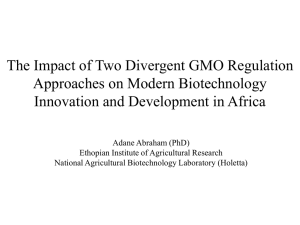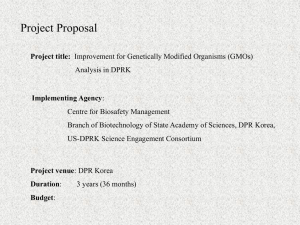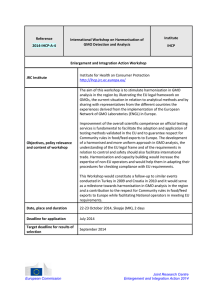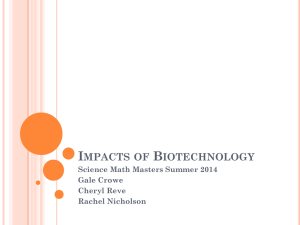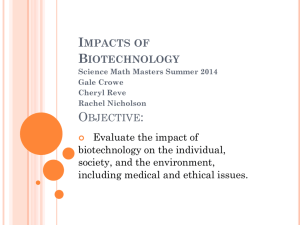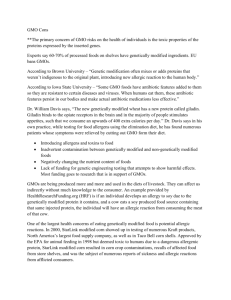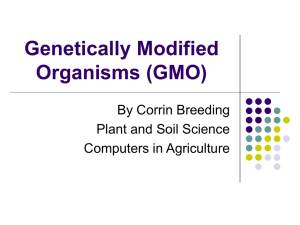Briefing of Parliamentary Committee on GMOs
advertisement
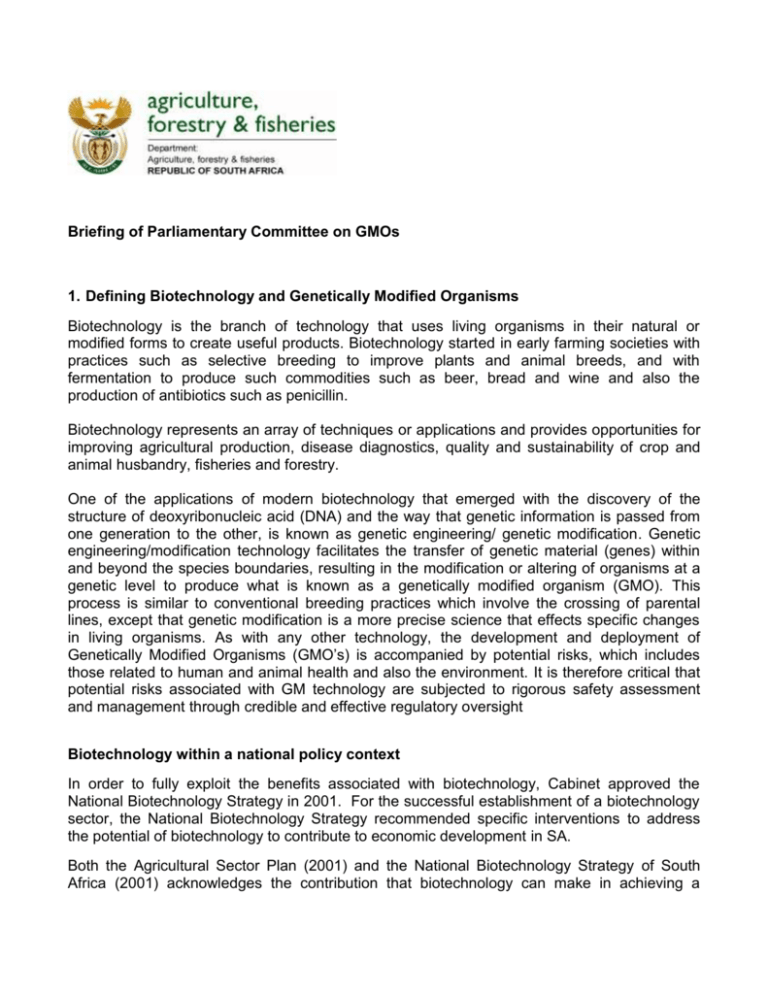
Briefing of Parliamentary Committee on GMOs 1. Defining Biotechnology and Genetically Modified Organisms Biotechnology is the branch of technology that uses living organisms in their natural or modified forms to create useful products. Biotechnology started in early farming societies with practices such as selective breeding to improve plants and animal breeds, and with fermentation to produce such commodities such as beer, bread and wine and also the production of antibiotics such as penicillin. Biotechnology represents an array of techniques or applications and provides opportunities for improving agricultural production, disease diagnostics, quality and sustainability of crop and animal husbandry, fisheries and forestry. One of the applications of modern biotechnology that emerged with the discovery of the structure of deoxyribonucleic acid (DNA) and the way that genetic information is passed from one generation to the other, is known as genetic engineering/ genetic modification. Genetic engineering/modification technology facilitates the transfer of genetic material (genes) within and beyond the species boundaries, resulting in the modification or altering of organisms at a genetic level to produce what is known as a genetically modified organism (GMO). This process is similar to conventional breeding practices which involve the crossing of parental lines, except that genetic modification is a more precise science that effects specific changes in living organisms. As with any other technology, the development and deployment of Genetically Modified Organisms (GMO’s) is accompanied by potential risks, which includes those related to human and animal health and also the environment. It is therefore critical that potential risks associated with GM technology are subjected to rigorous safety assessment and management through credible and effective regulatory oversight Biotechnology within a national policy context In order to fully exploit the benefits associated with biotechnology, Cabinet approved the National Biotechnology Strategy in 2001. For the successful establishment of a biotechnology sector, the National Biotechnology Strategy recommended specific interventions to address the potential of biotechnology to contribute to economic development in SA. Both the Agricultural Sector Plan (2001) and the National Biotechnology Strategy of South Africa (2001) acknowledges the contribution that biotechnology can make in achieving a globally competitive, profitable and sustainable agricultural sector. Within the context of agriculture, biotechnology has an important role to play as it offers the opportunity to increase production in a sustainable manner thereby reducing poverty and food insecurity whilst maintaining the natural resource base. In support of the biotechnology policy context, DAFF provides an enabling regulatory framework that facilitates the availability of GM technology in SA for safe use. While scientific research in the use of GM technology expands beyond the realm of agronomic traits to address issues such as drought tolerance and salinity issues in crops, animal vaccines and nutritionally enhanced foods, there is no doubt that the technology will continue to be part of agriculture’s future. Caution however still needs to be exercised, as the use of GM technology in isolation cannot be regarded as the overall panacea to address all agricultural challenges; instead the technology must be viewed as just one of the many Biotechnology tools available to the agricultural sector. We therefore advocate that the application of GMO technology be considered in line with the principles of the precautionary approach and be used in combination with a range of other sustainable technologies as provided for by biotechnology and existing conventional agricultural practices. 2. Legislation: Status of amendments to the Genetically Modified Organisms Act, 1997 (Act no. 15 of 1997) Activities* involving GMOS are regulated under the Genetically Modified Organisms Act, 1997 (Act 15 of 1997) which was implemented in 1999. The Act aims to ensure that all activities involving genetically modified organisms are carried out in such a way as to limit possible harmful consequences to human and animal health, the environment as well as potential influences on the South African trade and industry. GMO applications are subjected to a multidisciplinary process of scientific evaluation by an expert panel of scientists constituting the Advisory committee, before being considered by the Executive Council, the decision-making body currently represented by six different government departments (DAFF, DST, the dti, DoH, DEAT, DoL) that have been appointed by the Minister in terms of the GMO Act. Specific GMO activities that are approved by the Executive Council are regulated by way of permits and accompanying permit conditions and are monitored for compliance by inspectors of the DAFF. *'activity' means any activity with genetically modified organisms but is not limited to the importation, exportation, transit, development, production, release, distribution, use, storage and application of genetically modified organisms only;" International Obligations: Cartagena Protocol for Biosafety South Africa is a Contracting Party to the Convention on Biological Diversity (CDB). In 1994 the meeting of Parties to the CBD recognized the need to develop a protocol for the safe transfer, handling and use of genetically modified organisms. As a result, the Cartagena Protocol on Biosafety (CPB) was adopted by Parties to the Convention. The objective of the Cartagena Protocol on Biosafety is “to contribute to ensuring an adequate level of protection in the field of the safe transfer, handling and use of living modified organisms (genetically modified organisms) resulting from biotechnology that may have adverse effects on the conservation and sustainable use of biological diversity, taking also into account risks to human health and specifically focusing on transboundary movement”. SA acceded to the Protocol in 2003 and as a Contracting Party has to provide appropriate legal, administrative and other measures to implement the provisions of the Protocol. Amendment of the GMO Act, 1997 (Act No. 15 of 1997) To ensure alignment of the Act with provisions of the Protocol and related environmental legislation, certain amendments to the Act were proposed in 2005. The GMO Amendment Bill was subjected to the parliamentary legislative process and was approved and signed by the President in April 2007. During 2008 the accompanying regulations in support of the GMO Amendment Act were drafted and gazetted in order to solicit public input. After lengthy review and consultation of all comments with our Legal Services, the regulations were finalized and submitted for approval through publication in the Government Gazette. On 26 February 2010 both the proclamation of the GMO Amendment Act and the accompanying regulations were gazette for implementation. Some of the key amendments to the Act which are currently being addressed include: Protocols and procedures are in place and already implemented to address transboundary movement of GMOs in compliance with requirements of the Biosafety Protocol (imports/exports) Provisions of the Biosafety Protocol relating to risk assessment and risk management are already in place, however coordination with relevant government departments remain ongoing on how best to address related requirements for environmental and socio economic impact assessments. Notification procedures have been amended and the development of an official biosafety clearing house communication portal is complete. Administrative processes have been initiated to facilitate the expansion of representation on the Executive Council to include expertise from Arts and Culture, Water Affairs and Forestry. 3. Status of GM Crop Adoption in SA Under the GMO Act SA has approved the commercialization of GM maize, cotton and soybean. These three GM crops have been modified either for insect resistance and /or herbicide tolerance. In 2009 the area under GM crop production equalled 2, 1 million hectares (an increase of 17% over the previous year) allowing SA to retain its position as the eighth largest producer of GM crops in the world. Relative to the total production area reported for 2009, the adoption rate for GM maize was 78%, GM soybean was 85% and GM cotton between 92-95%. Cumulative benefits (income gain) to famers for the period 1998 to 2009 for GM maize, soybean and cotton crops in SA have been estimated at US$ 500 million (ISAAA, 2009 Report). Independent socio-economic impact studies, focusing mainly on insect resistant maize and cotton, have shown that both commercial and small scale farmers benefit from the adoption of GM technology but only in seasons when there is significant insect pressure (infestation). Some of the benefits enjoyed by farmers have included higher yields as a result of reduced pest damage, savings on reduced pesticide applications and increased farm income. Since GM crops approved for commercial production in SA are considered as safe as their conventional non GM counterparts, no segregation systems are required to distinguish between GM and non GM crops. There are however markets that prefer non-GM or conventional commodities that meet specific thresholds on GM presence. To accommodate such requests voluntary identity preservation systems, based on SABS standards, are in place for separate production, storage and shipping of non-GM products. These are arrangements strictly between producer, seller and buyer. 4. Status regarding the transboundary movement of GMOs (Imports/exports) Transboundary movement of GMOs can be categorized either as GM seed for intentional introduction into the environment (planting) or as a commodity for direct use as food, feed or processing (not for planting). Import and export procedures required for both of these categories of GMOs strictly comply with provisions as prescribed by articles 7, 8, 11 and 18 of the Protocol. What this means is that before an import can takes place, South Africa has the right to firstly be notified of the GM events contained in the consignment, request all the relevant risk assessment information to assess the safety of these specific GM events and thereafter make a decision on whether to import based on the outcome of the safety assessment. The decision to authorize importation may be subject to specific conditions to ensure safety and manage potential risks as it relates to the human and animal health and the environment. A similar process is followed for the export of GM consignments from SA. For exports, the importing countries need to be notified of the GM status of the consignment and based on the outcome of their decision to grant approval for the import the corresponding export permit will be issued. It is important to note that while South Africa has made great strides in implementing the necessary procedures to facilitate transboundary movements in accordance with the Protocol, most contracting parties who are also our trading partners have made very little progress in this regard. Current status of GMO Commodity Imports for food, feed and processing Socio-economic factors such as the impact of GM maize commodity imports on the production of maize in SA and potential price distortions are considered by the Executive Council when taking a decision on any proposed GMO activity. In 2005, the Executive Council decided to suspend all current and new applications requesting commodity clearance approval for the import of GM maize. This decision was based on concerns raised by the dti with regard to developments in the trade of agricultural commodities and the extent to which these approvals may disadvantage local producers. To facilitate informed decision making by the Executive Council, a study was commissioned on the potential impact of GM grain imports on the South African trade. The outcome of the study broadly confirmed the benefits to the country if domestic production of approved GM maize events is allowed and that policy decisions to restrict access to new GM maize events will gradually disadvantage both domestic producers and consumers of maize. Their specific recommendation regarding commodity imports follows that such imports should be the exception rather than the rule during times of severe domestic shortages. The outcome of the study was presented to the Executive Council early in 2007 and was referred to the dti for consideration. The dti subsequently responded to the study by formulating a position with the following recommendations: 1. South Africa allows the importation of GM commodity clearance only if the DAFF is in a position to ensure the development, implementation and policing of measures and regulations under the GMO Act that will ensure maintenance of our trade and export credibility in GM products and to safeguard our biodiversity against incidental or unintended releases of GM events not yet approved for commercial cultivation in SA. 2. Commodity clearance should exclude the import of GM sugarcane in the absence of scientific testing to verify the GM content of the sugarcane. 3. As our SACU trading partners are very sensitive to trade in GM products, it recommends that regulatory measures be established for commodity clearance be conducted in close cooperation with SACU partners taking into consideration the possible risk of incidental or unintended transboundary movement of GM products to SACU countries. In response to the dti’s concerns, the Executive Council commissioned several interventions to strengthen regulatory control measures for GM commodities. In the short term commodity permit conditions were reviewed to address issues relating to liability, monitoring and reporting; permit holders were required to submit individual import protocols that address risk management measures in the event of emergencies; and an SABS standard document was developed in conjunction with relevant industry stakeholders to specify requirements for the receiving, handling, transportation and storage of living modified organisms (LMO) not approved for general release. In the long term the Executive Council recommended that the feasibility of establishing a GMO testing facility be investigated to facilitate additional monitoring and risk profiling in terms of our obligations for transboundary movement of GMOs under the Biosafety Protocol. Since decision making by the Executive Council is consensus based, the Council is currently awaiting the final position by the dti confirming whether they are satisfied that the interventions as outlined above addressed their specific concerns. Thus far, all commodity applications submitted since the 2005 moratorium have been subjected to the required regulatory review process and have already been scientifically assessed in terms of their environmental, food and feed safety. A decision on the applications will be made available as soon as confirmation is received from the dti. GMO Commodity Exports: GM maize exports to Kenya The same consideration that is given to SA when it has to decide on importing a GM commodity has to be extended to any other importing Party to the Protocol, when SA is the exporting country. Considering this statement, the issuing of the commodity export permit for the GM maize consignment followed due process in terms of our obligations under the Protocol. As both Kenya and South Africa are Parties to the Protocol, this required that the Kenyan Government authorities firstly authorised the import before the Department could issue a commodity export permit. Upon receipt of this authorisation the Department issued export permits for 240 000 tons of a mixed consignment of GM maize to Kenya for use as a commodity (not for planting) during February 2010. Due to the unconfirmed media reports that the consignment was rejected, the Department has followed up with the Kenyan government to confirm the status of the GM maize consignment at the port of Mombasa. Reports received from Kenyan Plant Health Inspectorate Services (KEPHIS) are that the consignment has been discharged to a warehouse facility. No further official reports regarding the consignment have since been communicated. It is important to note that the trading of the GM maize consignment was a transaction between industry representatives between Kenya and South Africa and that as the SA government; DAFF’s responsibility was only to provide an enabling regulatory environment for the export to take place in compliance with its international obligations. 5. Related issues associated with GMOs A] Labelling GM labelling of foods, feeds and other consumer products has been a point of contention in many fora. Labelling of products derived from or containing GM traits that have been approved for commercial use, falls outside the scope of the GMO Act, 1997. The labelling of GM foodstuffs in South Africa is legislated by the Department of Health in terms of Regulations under its Foodstuffs, Cosmetics and Disinfectants Act, 1972 (Act 54 of 1972) and is based on the nutritional and safety aspects of foodstuffs. In terms of this legislation labelling requirements are applicable to GM foodstuffs that are not substantially equivalent to their non-GM conventional counterpart (determined via risk assessments in terms of the GMO Act). Labelling is therefore specifically required for GM foodstuffs when they differ significantly from their conventional counterparts in terms of food composition, nutritional value, storage, preparation or cooking requirements, if it contains a potential allergen or genes of human or animal origin. The Regulations also make provision for enhanced characteristic claims which indicates that such claims need to be verified by an appropriate certifying body accredited to the South African National Accrediting Services (SANAS) and that claims are limited to ‘genetically-enhanced foodstuff’ or “genetically-improved foodstuff’. The Department of Health is also the Codex contact point for South Africa and in view of its continued participation on the Codex Committee for Food labelling, it considers its current regulations for GM labelling appropriate until such time that the Codex Food labelling committee has made a ruling on international standards for the labelling of GM foodstuffs. The DoH’s labelling regulations do not address the mandatory labeling of all foods produced by genetic modification. The DoH is of the view that such a measure will have a significant economic effect that will impact directly on the price of food. This Increased food price as a result of mandatory labeling is of particular concern to government taking into account the millions of South African living under poverty conditions. In 2009 the Department of Trade and Industry also entered the GMO labelling spotlight with the inclusion of mandatory labelling provisions in the Consumer Protection Act, 2008 (Act 68 of 2008). The Consumer Protection Act provides for labelling of goods containing GM components or ingredients in the interest of consumers’ rights to disclosure and information. The regulations to support the implementation of the labelling provisions are in the process of being developed. B] Liability One of the key provisions of the Cartagena Protocol is Article 27 on Liability and redress which proposes international rules for liability and redress in the event of damage cause by the transboundary movement of GMOs. The exact provisions for liability and redress are currently still being negotiated amongst Parties and after much debate Parties have finally agreed to work towards a legally binding instrument in the form of a Supplementary Protocol. While South Africa’s legislation already provides for a fault based administrative system to address liability and redress, concerns remain as proposals are being considered by Parties to also include strong civil liability provisions within the protocol text. Because of the legal implications, South Africa does not support the inclusion of a strong civil liability provision in the Supplementary Protocol but instead supports a civil liability provision that will allow for flexibility of language and provides countries with a choice when drafting their legislation. C] The Precautionary Approach A common criticism against the current GMO Act is that it does not embody the principles of the precautionary approach. The precautionary approach holds that uncertainty regarding serious potential harm to the environment is not a valid ground for refraining from taking a decision, which could include preventative measures. The chief characteristic of the precautionary approach is that it operates as an enabling action. It authorizes the action of taking preventative measures in circumstances of scientific uncertainty. This may mean that you impose specific conditions, which would act as your preventative measures, into a decision to approve the proposed activity as a precautionary measure in approving the activity. You can therefore apply the precautionary approach and still approve an activity. Where decision is necessary, the following factors, based on the precautionary approach, are taken into account • Proportional to risk • Non-discrimination • Consistent • Based on cost-benefit assessment • Subject to review • Capable of assigning responsibility for producing scientific evidence Considering the case-by-case approach and the process followed (which includes the six elements listed above) in considering all activities under the Act, it is our view that the precautionary approach is adopted in the decision-making procedures contained in the Amended GMO Act. D] Transparency of the Regulatory System – Poor interaction and Feedback A general comment often expressed by the anti-lobby groups is the lack of access to information. The GMO Act requires the applicant to make a public notification of his/ her intention to introduce a GMO into the environment. Members of the general public can then access the non-confidential information from the DAFF and provide comments on the application. The Executive Council also considers such comments prior to taking a decision. We are continuously striving to improve public access and participation. Information on permits issued, relevant information pertaining to EC decisions, guideline documents etc. are published on the departmental website. Apart from the DAFF website, stakeholders are able to access non confidential information relating to GMOs via administrative procedures provided for in terms of the Promotion of Access to Information Act, 2000. In terms of obligations under the Cartagena Protocol, the SA Biosafety Clearing House Website is near completion and will facilitate information exchange on all risk assessment data and decision making on GMOs within SA and between SA and other member countries to the Protocol.
